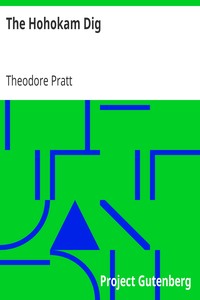The Hohokam Dig by Theodore Pratt
"The Hohokam Dig" by Theodore Pratt is a historical fiction novel written in the mid-20th century. The book explores the intersection of modern science and ancient history through the story of two scientists, George Arthbut and Sidney Hunt, as they investigate the mysteries surrounding the Hohokam culture of prehistoric America. The narrative takes a creative turn as it delves into the realm of spirituality and vision, where the characters, through unexpected events,
encounter actual Hohokam Indians transported to their time. In the story, George and Sidney, ethnologist and archaeologist respectively, arrive at the Hohokam dig site to uncover the reasons behind the seemingly abrupt disappearance of ancient desert inhabitants. Their research takes a surprising twist when they find themselves confronted by real Hohokam villagers who, guided by their medicine man, Huk, have been brought forward in time. Through their interactions, the scientists learn not only about the past of the Hohokam but also about their struggles and fears regarding their ever-changing world. The plot thickens as the scientists seek to record their findings, only to face the immediate challenge of these ancient people's return to their own time and the obliteration of the knowledge they sought to obtain. Ultimately, the novel blends adventure, mystery, and the depth of human history with speculative elements, drawing readers into a thought-provoking exploration of culture and the consequences of discovery. (This is an automatically generated summary.)
Read or download for free
| How to read | Url | Size | |||
|---|---|---|---|---|---|
| Read now! | https://www.gutenberg.org/ebooks/29793.html.images | 52 kB | |||
| EPUB3 (E-readers incl. Send-to-Kindle) | https://www.gutenberg.org/ebooks/29793.epub3.images | 83 kB | |||
| EPUB (older E-readers) | https://www.gutenberg.org/ebooks/29793.epub.images | 82 kB | |||
| Kindle | https://www.gutenberg.org/ebooks/29793.kf8.images | 172 kB | |||
| older Kindles | https://www.gutenberg.org/ebooks/29793.kindle.images | 166 kB | |||
| Plain Text UTF-8 | https://www.gutenberg.org/ebooks/29793.txt.utf-8 | 45 kB | |||
| Download HTML (zip) | https://www.gutenberg.org/cache/epub/29793/pg29793-h.zip | 81 kB | |||
| There may be more files related to this item. | |||||
Similar Books
About this eBook
| Author | Pratt, Theodore, 1901-1969 |
|---|---|
| Title | The Hohokam Dig |
| Series Title | Produced from Fantastic Universe November 1956. |
| Credits |
Produced by Greg Weeks, Stephen Blundell and the Online Distributed Proofreading Team at www.pgdp.net |
| Reading Level | Reading ease score: 84.7 (6th grade). Easy to read. |
| Language | English |
| LoC Class | PS: Language and Literatures: American and Canadian literature |
| Subject | Science fiction |
| Subject | Short stories |
| Category | Text |
| EBook-No. | 29793 |
| Release Date | Aug 24, 2009 |
| Most Recently Updated | Jan 5, 2021 |
| Copyright Status | Public domain in the USA. |
| Downloads | 174 downloads in the last 30 days. |
| Project Gutenberg eBooks are always free! | |

